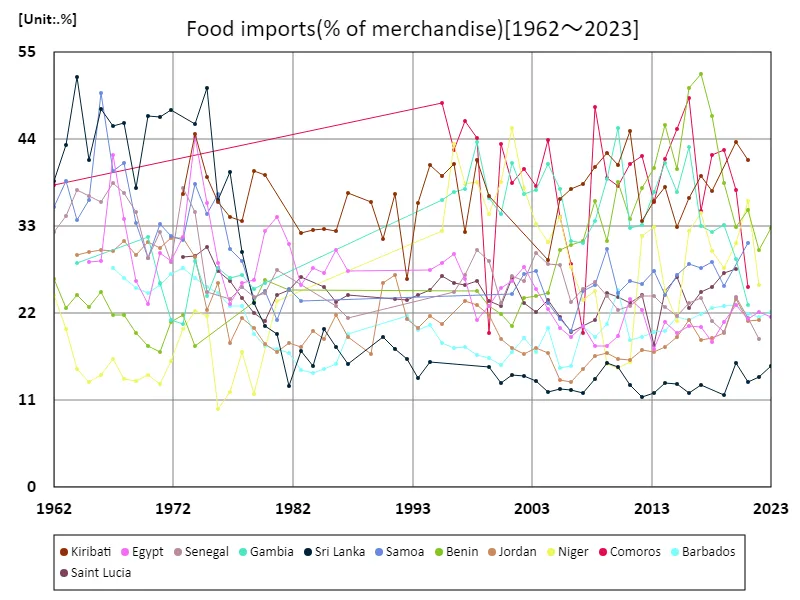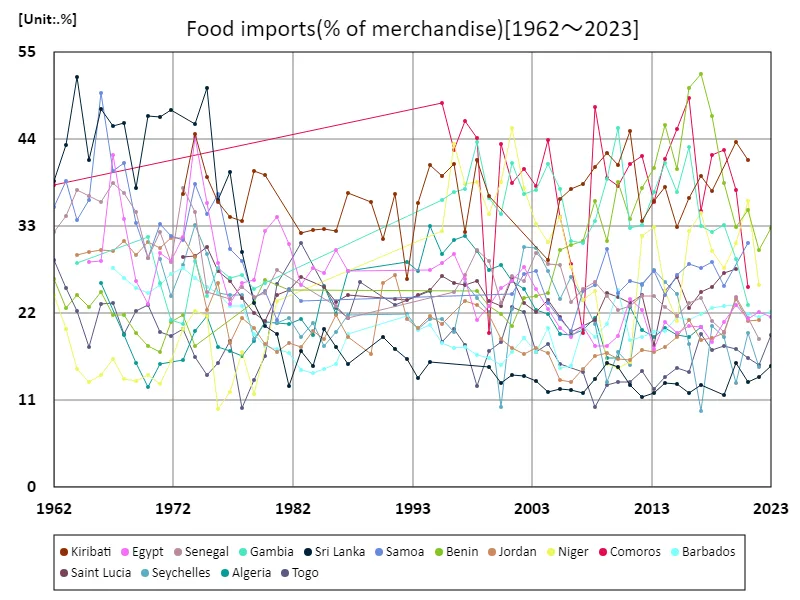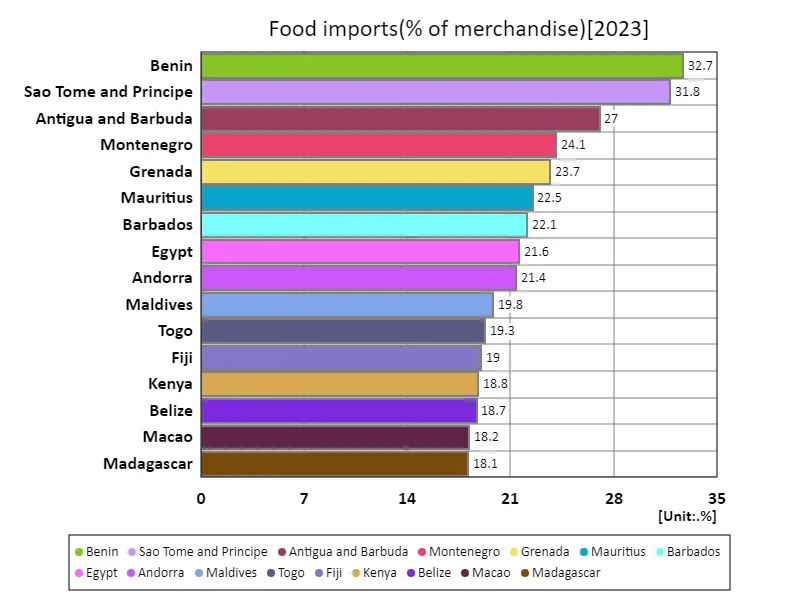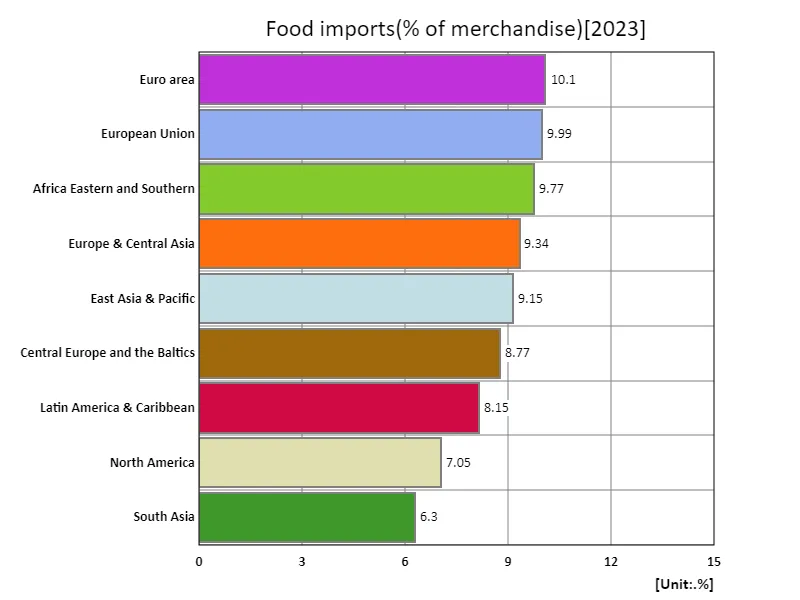Abstract
Data for 2023 shows that Benin has the highest food import ratio at 32.7%. This reflects the country’s inadequate economic structure and agricultural production capacity to meet food demand. Benin has an underdeveloped agricultural sector and is unable to become self-sufficient, forcing it to import large amounts of food. This high food import ratio is notable when compared with other African countries. In general, countries with a high food import ratio often have economic challenges, a lack of production technology, or harsh climatic conditions. In the case of Benin, the country is highly dependent on trade, and food security and economic stability are considered important issues. This trend will require close monitoring as it will also be influenced by changes in regional agricultural policies and international trade relations.
Food imports (comparison of goods)
Looking at data from 1962 to 2023, Benin stands out as a country with a high proportion of food imports. In particular, in 2017, the rate reached an all-time high of 52.3%, and has now increased to 62.6%. This increase is due to limitations in the country’s agricultural production, climate change and economic challenges. Benin’s agriculture sector remains underdeveloped and the country remains dependent on imports as domestic food supplies cannot keep up with demand. Increases in food imports are also influenced by international trade trends, price fluctuations and policy changes. In particular, Benin is in a position where it has to import more food as price fluctuations and rising transport costs take their toll. Furthermore, as the country’s economy grows and living standards improve, demand for food is increasing, leading to greater reliance on imports. While these trends are common to other African and developing countries, Benin’s extreme dependency is unique. The future will require greater self-sufficiency and improved international trade.


The maximum is 52.3%[2017] of Benin, and the current value is about 62.6%
Food imports (product ratio) (worldwide)
Considering data from 1962 to 2023, Benin’s food import ratio shows a notable increase. After hitting a high of 52.3% in 2017, it has now increased to 62.6%. This increase reflects limits on domestic agricultural capacity, climate change and growing economic challenges. Benin’s agriculture sector remains underdeveloped, and climatic and infrastructure problems mean domestic food production cannot keep up with demand, leading to increased reliance on imports. This trend is also linked to changes in Benin’s economy and society. While rising living standards and urbanization are increasing demand for food, the country’s agricultural production is not able to meet it. Fluctuations in international trade and rising prices also play a role. Future challenges will include improving food self-sufficiency and diversifying trade.


The maximum is 52.3%[2017] of Benin, and the current value is about 62.6%
Food imports (commodity ratio) (worldwide, latest year)
According to the 2023 data, Benin has the highest food import ratio at 32.7%, which indicates that the country imports a very large amount of food. The average value is 12.9%, and the overall total reaches 1,230%, but this is likely due to the way the data was compiled and the number of countries taken into account in the calculation. Countries with a high food import ratio generally have insufficient food production domestically or find it difficult to produce food due to climatic conditions or economic reasons. Countries with a high food import ratio, like Benin, face challenges including underdeveloped agriculture, climate change and lack of infrastructure. This high dependency increases risks to food security and economic stability. In contrast, the average ratio of 12.9% indicates that many countries have a certain degree of self-sufficiency, but are also dependent on international trade. The high overall total of 1,230% suggests that the data is multinational, reflecting the widespread global nature of food imports. In the future, countries will likely need to increase food production and rethink their trade strategies.


The maximum is 32.7% of Benin, the average is 12.9%, and the total is 1.23k%
Food imports (commodity ratio) (region, latest year)
According to 2023 data, the highest proportion of food imports is in the Eurozone at 10.1%, indicating a relatively high food dependency within the Eurozone. The overall average ratio was 8.73%, indicating that many countries are relatively self-sufficient, although they depend on some food imports. The combined percentage of 78.6% represents the total value for all countries surveyed and reflects the widespread nature of multinational food imports. The euro area’s high ratio reflects the limitations of agricultural production and diverse consumer needs within the region, and also takes into account the impact of regional economic integration and free trade. Eurozone countries are highly economically integrated and food imports play an important role as part of international supply chains. The average ratio of 8.73% reflects the balance between developed and developing countries and indicates differences in each country’s production capabilities and consumption patterns. In the future, sustainable production methods and trade policy adjustments will be required.


The maximum is 10.1% of Euro area, the average is 8.73%, and the total is 78.6%



Comments